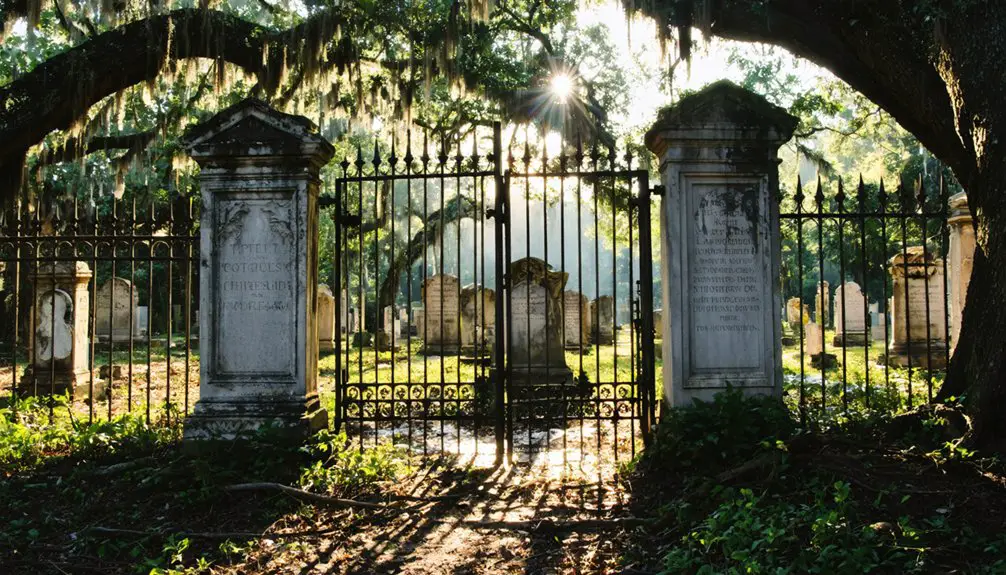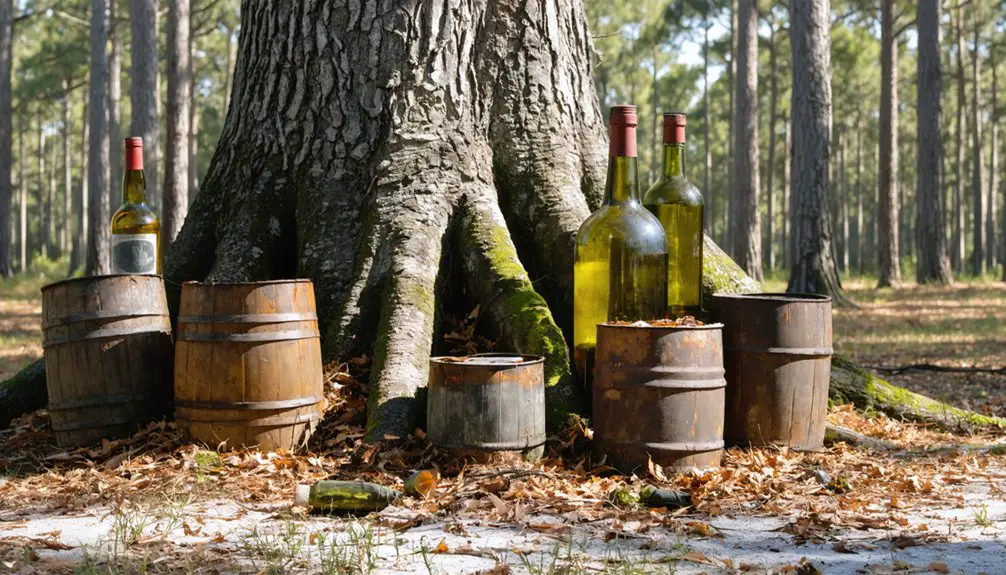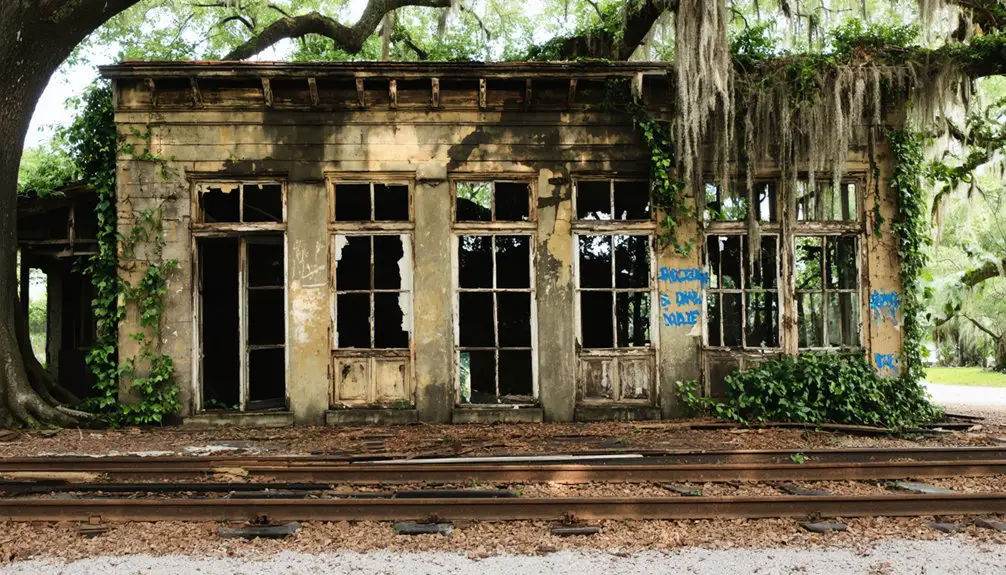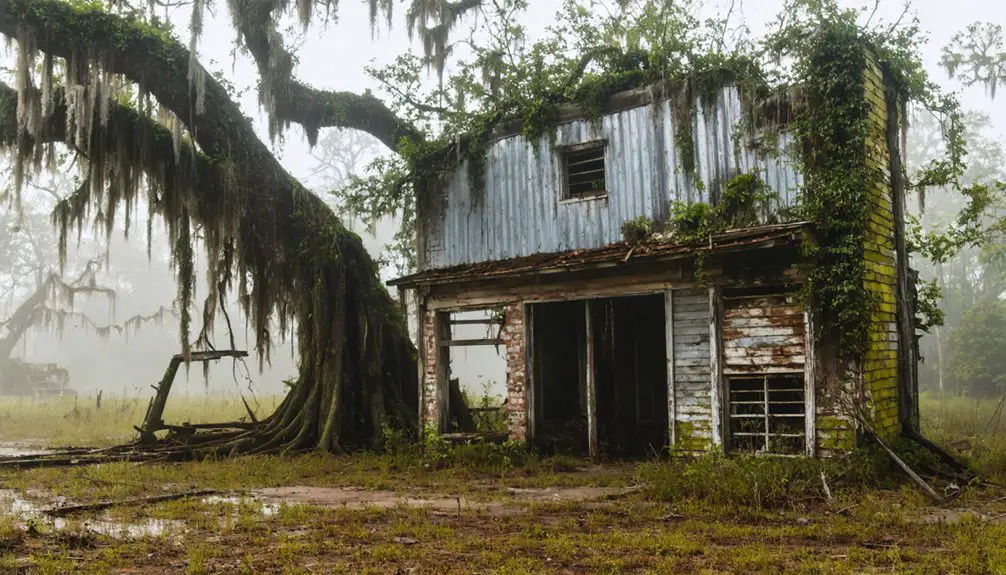You’ll find Orleans, Florida‘s remains hidden beneath dense woodland growth, where a close-knit farming community of 100 residents once thrived in the 1890s. The settlement centered around citrus groves and railroad access until the Great Freeze of 1894-95 devastated local agriculture. Today, only the Orleans Township Cemetery and scattered foundations remain visible, while artifacts like turpentine cups and weathered headstones tell deeper stories of this lost community’s determined spirit.
Key Takeaways
- Orleans, Florida was established in 1885 by Reverend Young as an agricultural settlement that grew to approximately 100 residents by 1895.
- The town’s economy centered around citrus production until the Great Freeze of 1894-95 devastated local groves.
- Economic hardships, including the Great Depression, droughts, and crop diseases, forced families to abandon their lands.
- Nature has reclaimed the former town site, transforming it into woodland with only foundations and ruins remaining.
- The Orleans Township Cemetery survives as a protected historical landmark, preserving the memory of early settlers.
The Birth of a Florida Farming Town
Although Orleans, Florida began as part of indigenous territories rich in ecological resources, its transformation into a colonial settlement marked the beginning of significant changes in the region.
Indigenous peoples thrived in Orleans, Florida before colonial settlement forever altered the landscape and destiny of this resource-rich territory.
You’ll find the town’s early settlement patterns were influenced by English colonists moving eastward along coastal areas, bringing with them traditional farming methods from Plymouth Colony.
When you explore Orleans’ colonial agriculture roots, you’ll discover how settlers cleared land for farming, establishing a community focused on subsistence crops like corn, rye, and wheat. French diplomacy with local tribes established crucial trade relationships that helped the settlement survive its early years.
They adapted English farming techniques to Florida’s unique coastal environment, taking advantage of fertile soil and nearby waterways.
The strategic location near rivers and coastal waters proved essential for early settlers, who relied on these routes to transport their agricultural goods and maintain critical connections with neighboring communities. Much like the vital Bayou St. John trade route established by Native Americans in other colonial settlements, these waterways became crucial for commerce and transportation.
Daily Life in Late 1800s Orleans
In 1800s Orleans, you’d find a close-knit farming community of about 100 people gathering regularly for church services, agricultural work parties, and seasonal celebrations tied to the harvest cycles. The turpentine industry left scattered Herty cup remnants throughout the area.
Your daily meals would consist primarily of home-grown produce and preserved foods, with women preparing both family fare and medicinal teas from local herbs and fruits. Families tended geometric style beds in their gardens, maximizing space for both ornamental and edible plants.
If you were part of an Orleans family, you’d participate in a social structure where neighbors supported each other through crop failures and illness, sharing resources and labor while maintaining strong religious values established by the town’s founder, Reverend Young.
Community Activities and Traditions
Life in late 1800s Orleans revolved around a close-knit community of roughly 100 residents who shared deep social and religious bonds.
You’d find townspeople gathering regularly for church services led by Reverend Young, while seasonal community events marked important agricultural milestones throughout the year. The Orleans Township Cemetery served as both a sacred space and a cultural landmark where families would honor their ancestors. Many residents found solace visiting loved ones at the local cemetery plots dating from 1890 to 1912.
When you weren’t tending to citrus groves or collecting turpentine, you might join social gatherings near homesteads or along the old town roads. The devastating great freezes of 1894-1895 forced many families to abandon their citrus farms and seek opportunities elsewhere.
These informal meetups strengthened neighborhood ties and offered relief from daily work. The community’s intimate size meant you’d know everyone by name, fostering a spirit of mutual support that proved essential during challenges like epidemics and crop failures.
Local Food and Agriculture
The fertile soil of Orleans supported a diverse agricultural landscape centered around thriving citrus groves in the late 1800s.
You’d find local farmers practicing sustainable practices as they balanced commercial citrus production with subsistence farming, often rotating their crops to maintain soil health. While oranges dominated the agricultural scene, you could also spot pineapples and bananas growing alongside home gardens. Like many early Florida settlements, Orleans relied on natural resource exploitation for its economic foundation.
If you’d visited Orleans then, you’d have seen families supplementing their farming income through turpentine harvesting from nearby pine forests.
Your diet would’ve consisted mainly of fresh local produce, preserved foods, and wild game from the surrounding woods. The railroad station guaranteed your harvests could reach broader markets, though the devastating freeze of 1894-95 would eventually bring this prosperous agricultural era to an end.
Family and Social Structure
While Orleans maintained a modest population of around 100 residents, its tight-knit social fabric wove together multiple generations living and working side by side.
Family dynamics centered around shared labor, with households adapting their roles between farming, turpentine work, and logging to survive. You’d find community roles naturally emerging, from Reverend Young’s spiritual leadership to informal arrangements of mutual support between neighbors. Like many of Florida’s ghost town communities, Orleans would eventually succumb to economic pressures and changing transportation routes.
- Families gathered for social events near the cemetery grounds, strengthening bonds through shared experiences.
- Multi-generational homesteads dotted the landscape, with grandparents, parents, and children pooling their skills and resources.
- Daily routines followed the rhythm of seasons, with community members coordinating their efforts during harvest times and helping those in need.
Agricultural Dreams and Citrus Groves
You’ll find Orleans’s early citrus ambitions reflected the broader pattern of Florida’s 1880s grove expansion, as settlers established orchards near waterways for easier transport.
Like many communities of that era, Orleans’s farmers faced the harsh realities of grove cultivation, including the lengthy maturation period and the constant threat of devastating freezes. By the late 1800s, citrus production had reached one million boxes annually across Florida.
The Great Freeze of 1894-95 dealt a crushing blow to Orleans’s agricultural dreams, destroying local groves and contributing to the town’s eventual decline. Early settlers relied on Native American dispersal of orange seeds from Spanish sources to establish their first groves.
Early Citrus Growing Success
Following Spanish explorers‘ introduction of citrus to Florida in the early 1500s, commercial growing didn’t gain significant traction until after Florida became a U.S. territory in 1821.
You’ll find that citrus innovation truly flourished during the mid-1870s, when “orange fever” swept through the region, attracting ambitious entrepreneurs seeking agricultural freedom and prosperity.
Despite the challenges of long maturation periods and harsh weather, the agricultural resilience of early growers shaped the industry’s foundation through improved cultivation techniques and transport methods.
- Growers hand-pollinated Valencia oranges with Mediterranean varieties, creating hardier hybrids
- Local nurseries developed cold-resistant varieties suited to Florida’s unique climate
- Railways and steamboats opened new markets, allowing fresh citrus to reach northern consumers
From Fields to Failure
As the Great Depression gripped the nation in the early 1930s, Orleans’ once-thriving citrus industry faced devastating setbacks that would ultimately seal its fate.
You’d have witnessed local farmers struggle as crop prices plummeted to historic lows, making it impossible to maintain their groves profitably.
The economic hardships weren’t your only enemy. Severe droughts withered crops, while floods disrupted planting cycles.
Invasive species and citrus diseases attacked your trees, requiring costly treatments you couldn’t afford. With banks failing and credit vanishing, you’d have found it impossible to reinvest in your farm’s future.
The tight-knit community began to unravel as crop failures forced families to abandon their lands. Labor shortages mounted as agricultural workers, facing widespread poverty, were forced to seek opportunities elsewhere, leaving Orleans’ fields to slowly wither away.
Pioneering Agricultural Settlement
The story of Orleans began in 1885, when Reverend Young envisioned a thriving agricultural settlement in the heart of Citrus County, Florida.
You’ll find the pioneering spirit alive in the way settlers transformed untamed wilderness into productive citrus groves, implementing citrus innovations like grafting techniques to maximize yields.
The small community grew steadily, reaching about 100 residents by 1895, with agricultural challenges met head-on through determination and ingenuity.
- Rows of carefully tended orange trees stretched across the landscape, their fragrant blossoms promising sweet rewards.
- Railroad cars loaded with fresh citrus waited at the nearby station, ready to carry Orleans’ bounty to distant markets.
- Local farmers gathered at dawn, tools in hand, to nurture their groves with time-tested growing methods.
The Great Freeze’s Devastating Impact
During late 1894 and early 1895, a devastating series of freezes struck Florida’s citrus-growing regions, delivering an unprecedented blow to Orleans and countless other agricultural communities.
You would’ve witnessed the complete citrus devastation as temperatures plunged below 20°F for several nights, causing trees to split and die from ice formation within their trunks.
The economic collapse that followed was swift and merciless.
Land values in Orleans plummeted from $1,000 to just $10 per acre, forcing many of your neighbors to abandon their groves and seek opportunities elsewhere.
Local merchants who’d extended credit to growers faced bankruptcy.
The once-thriving citrus industry that sustained Orleans simply vanished, as surviving growers relocated south to warmer regions like Indian River and Palm Beach County.
Orleans Cemetery: A Silent Witness

Hidden within Withlacoochee State Forest‘s wooded expanse lies a poignant reminder of Orleans’ former significance – its cemetery, where weathered tombstones and crumbling markers tell silent stories of the community’s pioneers.
Dating from 1881 to 1912, this historical marker stands as a tribute to the area’s early settlers, with burial dates spanning from the early 1800s through the turn of the century.
Weathered stones mark time’s passage, chronicling the lives of early pioneers from the 1800s through this sacred ground’s final interment.
- Ancient brick and stonework peek through encroaching vegetation, hinting at craftsmanship from a bygone era.
- Scattered concrete markers dot the protected grounds, many worn smooth by time’s relentless march.
- A memorial plaque honors the “lost souls” whose identities have faded like the town itself.
The cemetery’s significance extends beyond its role as a burial ground – it’s a tangible connection to Citrus County’s rural development and the transient nature of pioneer settlements.
Lost Streets and Forgotten Paths
Deep within Withlacoochee State Forest’s maze-like trails, you’ll find vanishing traces of Orleans’ original streets and pathways, now largely reclaimed by nature.
These forgotten pathways, once essential arteries of the 1885 settlement, reveal themselves through sandy stretches and old tire ruts that you can still discover during historical exploration.
Near Trail 10 off County Route 581, you’ll encounter scattered artifacts like Herty cup fragments and old cistern remains that mark where homes and businesses once stood.
While barricades now restrict vehicle access, you can still venture on foot through these ghostly corridors.
The forest’s undergrowth has steadily erased most evidence of the town’s layout, but by following footpaths near Orleans Cemetery, you’re walking the same ground as the community’s original 100 residents.
Turpentine Industry’s Hidden Legacy

Before Orleans became a ghost town, the turpentine industry dominated its economic landscape, transforming virgin longleaf pine forests into a bustling center of naval stores production.
You can still trace Orleans’ turpentine heritage through the scattered remnants of copper stills and scored pine trees that once sustained entire families. The industry’s darker side reveals intense labor struggles, where workers – from freed slaves to convict laborers – faced grueling conditions in the pursuit of pine resin.
- Weathered “cat-face” scars on ancient pines, where workers carved deep cuts to collect precious gum
- Rusted metal drums and fragments of copper coils, silent witnesses to countless distillation cycles
- Worn paths between trees, where laborers once carried heavy buckets of raw resin to waiting stills
Nature Reclaims the Ghost Town
As decades of abandonment settled over Orleans, nature steadily reclaimed the once-bustling town site, transforming cleared fields and dusty streets into a dense woodland paradise.
You’ll find natural reclamation at work everywhere – old town paths disappear beneath fallen leaves, while saw palmetto and ferns embrace crumbling foundations.
The forest’s ecological succession is relentless, as native hardwoods and pines push through soil once tilled by settlers’ hands. Wildlife has made this ghost town their sanctuary, with small mammals and birds nesting among the ruins.
Even the sturdy structures haven’t resisted time’s green embrace. Brick walls slowly crumble, wooden remnants rot, and searching cisterns requires battling thick undergrowth.
What was once a community carved from wilderness has returned to its wild roots.
Preserving Orleans’ Historical Memory

While the physical remnants of Orleans fade into Florida’s wilderness, dedicated preservation efforts guarantee its historical legacy endures.
You’ll find the Citrus County Historical Society actively maintaining records and maps that tell Orleans’ story through carefully documented historical narratives. The Orleans Township Cemetery, protected by fencing and regular maintenance, serves as a focal point for community remembrance activities.
- Weathered headstones peek through wild vegetation, bearing silent witness to the lives of settlers like the McAtee family.
- Recovered turpentine cups and wooden cigar boxes paint a picture of daily life in this once-bustling town.
- Local historians and explorers share their discoveries through digital media, keeping Orleans’ memory alive for future generations.
Frequently Asked Questions
Were There Any Reported Ghost Sightings in Orleans Cemetery?
You won’t find any documented ghostly apparitions or cemetery hauntings at Orleans Cemetery. Despite local interest in the site’s history, there’s no credible evidence of paranormal activity in this historic burial ground.
What Happened to the Original Residents After Abandoning Orleans?
Like scattered seeds in the wind, you’d find Orleans’ original residents dispersed throughout Citrus County’s towns, with some joining the turpentine trade while others relocated via railroad to seek fresh opportunities.
Did Orleans Have a School or Church During Its Existence?
You won’t find direct evidence of formal Orleans education or religion – no confirmed school or church buildings existed, though the town’s founding by Reverend Young suggests possible informal religious gatherings took place.
What Native American Tribes Lived in the Orleans Area Before Settlement?
Like scattered shells on a coastal shore, you’ll find the Timucua culture dominated this region, leaving behind native artifacts that tell their story of living freely throughout the Orleans area before settlement.
How Many Buildings Were Originally Constructed in Orleans During Its Peak?
While you can’t know the exact count, archaeological evidence suggests multiple homesteads and farming structures existed, with the building architecture focused on residential homes and agricultural facilities during Orleans’ 1880s-1890s peak.
References
- https://floridatrailblazer.com/2018/04/10/orleans-ghost-town-in-citrus-county/
- https://www.youtube.com/watch?v=fvFk_JtmKdY
- https://cccourthouse.org/wp-content/uploads/2023/12/Ghost-towns-and-Cemeteries-of-Citrus-County.pdf
- https://www.youtube.com/watch?v=SQdvbhVUmNA
- https://floridatrailblazer.com/tag/ghost-towns/
- https://en.wikipedia.org/wiki/History_of_New_Orleans
- https://www.battlefields.org/learn/articles/founding-new-orleans
- https://worldfootprints.com/world-briefs/today-in-history-the-founding-of-new-orleans-may-7-1718-2/
- https://louisiana-anthology.org/texts/de_villiers/de_villiers–new_orleans_founding.html
- https://www.town.orleans.ma.us/1298/Orleans-History



